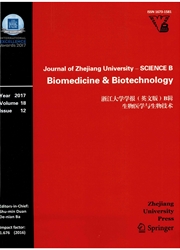

 中文摘要:
中文摘要:
全部的 phenolics 的内容;在叶子的可引出的压缩丹宁,枝条;Canarium 相册的茎 bark 是坚定的。从茎 bark 的压缩 tannings 的结构的异质被帮助矩阵的激光解吸附作用 / 电离 time-of-flight 质谱分析法(MALDI-TOF MS ) 描绘;原子磁性的回声(NMR ) 分析。结果显示出 procyanidins 代表性的信号的优势;prodelphinidins。另外, epicatechin;有 galloylated procyanidin 或 prodelphinidin 的 epigallocatechin 聚合物也被观察。丹宁用 1,1-diphenyl-2-picrylhydrazyl (DPPH ) 为他们的潜在的抗氧化剂活动被屏蔽;铁的还原剂 / 抗氧化剂力量(捆牢) 模型系统。从叶子提取的丹宁,枝条;茎 bark 都给清除的一个很好的 DPPH 激进分子看了活动;铁的减少力量。
 英文摘要:
英文摘要:
The contents of total phenolics and extractable condensed tannins in the leaves, twigs and stem bark of Canarium album were determined. The structural heterogeneity of condensed tannins from stem bark was characterized by matrix-assisted laser desorption/ionization time-of-flight mass spectrometry (MALDI-TOF MS) and nuclear magnetic resonance (NMR) analyses The results show the predominance of signals representative of procyanidins and prodelphinidins. In addition, epicatechin and epigallocatechin polymers with galloylated procyanidin or prodelphinidin were also observed. The tannins were screened for their potential antioxidant activities using l,l-diphenyl-2-picrylhydrazyl (DPPH) and ferric reducing/antioxidant power (FRAP) model systems. Tannins extracted from leaves, twigs and stem bark all showed a very good DPPH radical scavenging activity and ferric reducing power.
 同期刊论文项目
同期刊论文项目
 同项目期刊论文
同项目期刊论文
 期刊信息
期刊信息
